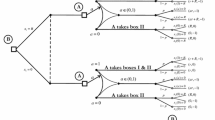Abstract
In Newcomb’s paradox you can choose to receive either the contents of a particular closed box, or the contents of both that closed box and another one. Before you choose though, an antagonist uses a prediction algorithm to accurately deduce your choice, and uses that deduction to fill the two boxes. The way they do this guarantees that you made the wrong choice. Newcomb’s paradox is that game theory’s expected utility and dominance principles appear to provide conflicting recommendations for what you should choose. Here we show that the conflicting recommendations assume different probabilistic structures relating your choice and the algorithm’s prediction. This resolves the paradox: the reason there appears to be two conflicting recommendations is that the probabilistic structure relating the problem’s random variables is open to two, conflicting interpretations. We then show that the accuracy of the prediction algorithm in Newcomb’s paradox, the focus of much previous work, is irrelevant. We end by showing that Newcomb’s paradox is time-reversal invariant; both the paradox and its resolution are unchanged if the algorithm makes its ‘prediction’ after you make your choice rather than before.
Similar content being viewed by others
References
Bar-Hillel M., Margalit A. (1972) Newcomb’s paradox revisited. British Journal of Philosophy of Science 23: 295–304
Benford G., Book D., Newcomb W. (1970) The tachyonic antitelephone. Physical Review D 2: 263–265
Binder P. (2008) Theories of almost everything. Nature 455: 884–885
Burgess S. (2004) The Newcomb problem: An unqualified resolution. Synthese 138: 261–287
Campbell R., Lanning S. (1985) Paradoxes of rationality and cooperation: Prisoners’ dilemma and Newcomb’s problem. University of British Columbia Press, Vancouver, BC
Collins, J. (2001). Newcomb’s problem. In International encyclopedia of the social and behavioral sciences. Oxford, UK: Elsevier Science.
Fudenberg D., Tirole J. (1991) Game theory. MIT Press, Cambridge, MA
Gardner, M. (1974). Mathematical games. Scientific American, 102.
Geanakoplos, J. (1997). The Hangman’s Paradox and Newcomb’s Paradox as psychological games (p. 1128). Yale Cowles Foundation paper.
Gibbard, A., Harper, W. (1978). Counterfactuals and two kinds of expected utility. In C. Hooker, J. Leach & E. McClennen (Eds.), Foundations and applications of decision theory. D. Reidel Publishing.
Hunter D., Richter R. (1978) Counterfactuals and Newcomb’s Paradox. Synthese 39: 249–261
Jacobi N. (1993) Newcomb’s Paradox: A realist resolution. Theory and Decision 35: 1–17
Koller D., Milch B. (2003) Multi-agent influence diagrams for representing and solving games. Games and Economic Behavior 45: 181–221
Levi I. (1982) A note on newcombmania. Journal of Philosophy 79: 337–342
Myerson R. B. (1991) Game theory: Analysis of conflict. Harvard University Press, Cambridge, MA
Nozick, R. (1969). Newcomb’s problem and two principles of choice. In Essays in honor of Carl G. Hempel (p. 115). Dordrecht: Synthese.
Osborne M., Rubenstein A. (1994) A course in game theory. MIT Press, Cambridge, MA
Pearl J. (2000) Causality: Models, reasoning and inference. Cambridge University Press, Cambridge, MA
Piotrowski, E. W., & Sladkowski, J. (2002). Quantum solution to the Newcomb’s Paradox. http://ideas.repec.org/p/sla/eakjkl/10.html.
Wolpert, D. H. (2008). Physical limits of inference. Physica D, 237, 1257–1281. More recent version at http://arxiv.org/abs/0708.1362.
Wolpert, D. H. (2010). Inference concerning physical systems. In F. Ferreira, B. Lowe, E. Mayordomo & L. M. Gomes (Eds.), CiE’10 Proceedings of the programs, proofs, process and 6th international conference on computability in Europe (pp. 438–447).
Wolpert, D. H., & Benford, G. (2010). What does Newcomb’s Paradox teach us? http://http://arxiv.org/abs/1003.1343 (v3).
Author information
Authors and Affiliations
Corresponding author
Rights and permissions
About this article
Cite this article
Wolpert, D.H., Benford, G. The lesson of Newcomb’s paradox. Synthese 190, 1637–1646 (2013). https://doi.org/10.1007/s11229-011-9899-3
Received:
Accepted:
Published:
Issue Date:
DOI: https://doi.org/10.1007/s11229-011-9899-3




